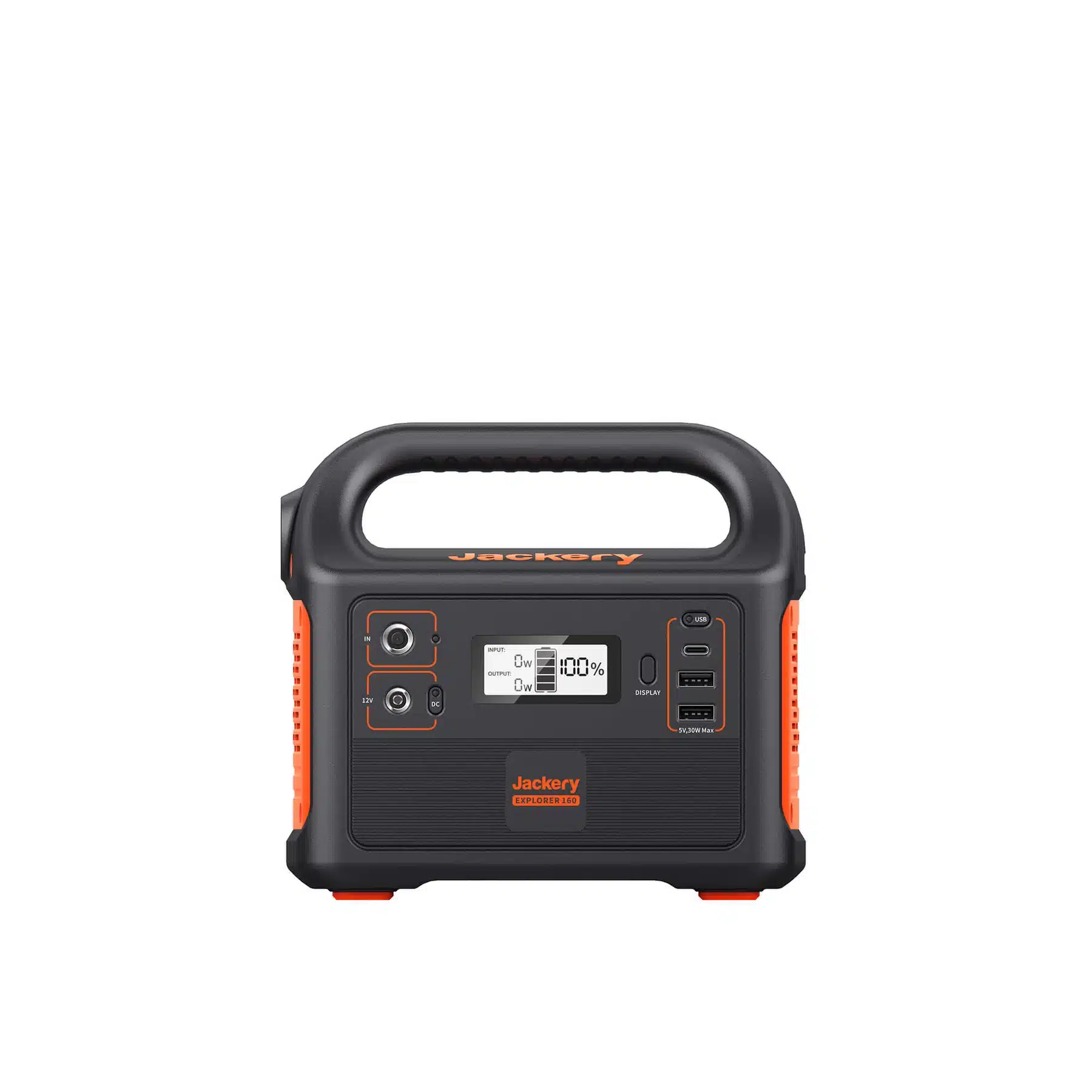This article will eventually be a mostly comprehensive guide to everything a Jackery portable power station can power.
I’m will start with the most frequently asked questions about Jackery power stations and then go into each version of Jackery’s Explorer series: the 240, the 500, the 1000, and even the beast that is the Jackery 2000!
However, I do recommend a LiFePO4 power station because they will last 5 to 6 times longer than a Jackery. (An example is the Anker 535 and their line of products.)
Table of Contents:
Jackery Explorer Overview
- What is a Jackery?
- How to charge a Jackery?
- About Jackery Lithium-ion Batteries
- Watt-hours – important to understand
- How long will a Jackery last?
- How much do Jackery’s Weigh?
- Product Table and Specs
What can a Jackery Power?
- What can a Jackery Explorer 160 Power?
- What can a Jackery Explorer 240 Power?
- What can a Jackery Explorer 300 Power?
- What can a Jackery Explorer 500 Power?
- What can a Jackery Explorer 1000 Power?
This article will help you:
- Understand the Jackery (and other) product lines
- Understand basic battery terminology to become a Power Station Master
- Choose the best Jackery Power Station for you.
Full disclosure: I own the Jackery Explorer 1000 and 2x 100W solar panels. I’ve owned a few other power stations, but nothing larger than the Jackery 1000.
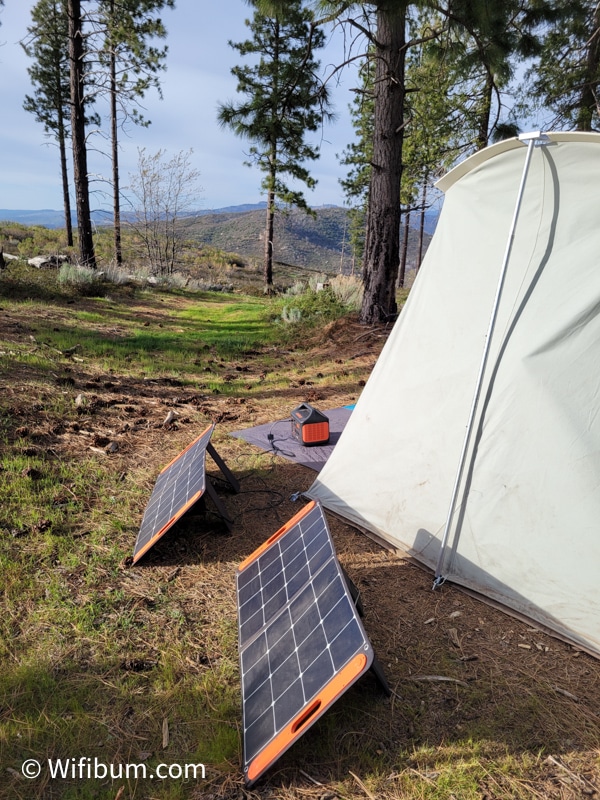
What is a Jackery?
A Jackery, or a Jackery Explorer, is a portable power station that you can use to charge and power a variety of electronic devices and appliances.
Jackery’s are essentially a large rechargeable battery pack. They have a variety of ports such as standard “home” AC outlets, USB and USB-C outlets.
It’s a simple concept, but it can get complicated when trying to figure out WHAT and HOW LONG you can power devices.
How to Charge a Jackery?
There are a few different ways to charge your Jackery portable power station, each with its own set of pros and cons.
Wall Plug Charging
The easiest way to charge a Jackery is by plugging it into an AC wall outlet. Each Jackery comes with a plug & cord required.
Simple!
This is the best option for weekend trips or trips you’ll grab the occasional motel/hotel to charge up.
Charging a Jackery with Solar Power
If you’re primarily using a Jackery for camping and boondocking, you’ll want to consider using Solar Power. Jackery has several solar panels available that pair well with their power station line up.
I’ll include what solar power you should consider at the end of each Explorer’s section. In general, the larger the battery pack, the larger the solar panel you need, or the quantity of solar panels increases.
Charging a Jackery with Solar Panels can take many hours of direct sunlight. This isn’t a great option if you’re always on the move. You’ll also have to consider the weather on your trips. Lastly, your solar panels will be less efficient during winter.
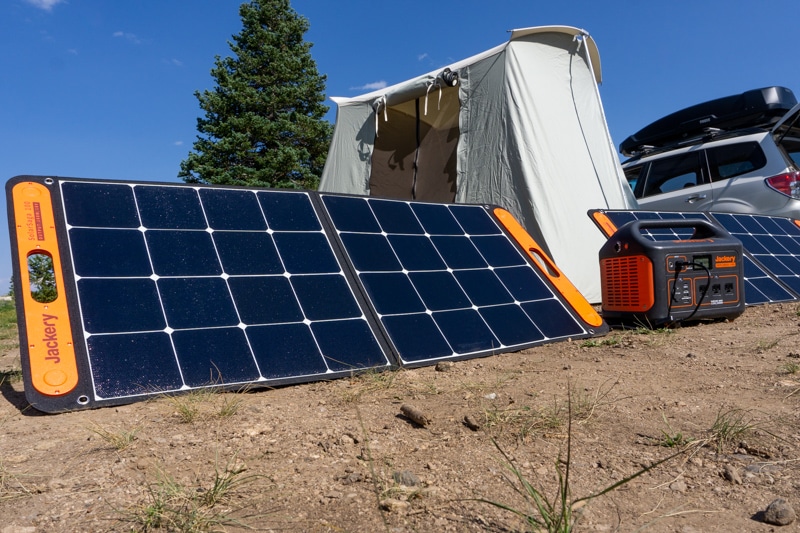
12V DC Sockets aka Your Car Cigarette Lighter
Going on a road trip? No problem! Your Jackery can also be charged using a car cigarette lighter adapter.
Some vehicles also have this 12V DC socket in the rear of the vehicle in a side panel. For example, when I’m driving, I put my Jackery near the rear of my vehicle and charge it while driving. It’s a little easier than having to have it in the passenger feet area.
“Inception” Charging
You can technically charge some Jackery’s with another Power Station.
I sometimes use my Jackery 1000 to charge small phone power banks, but not another smaller power station.
How long does a Jackery Last?
Most modern power station companies use lithium-ion batteries. Simply, these are rechargeable and known for their energy-to-size benefits and their long life cycles.
Each Jackery has two cycles that are important.
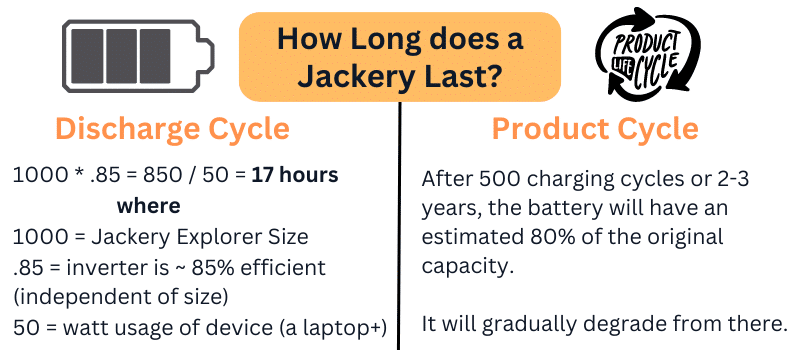
Discharge Cycle and a Discussion on Watt-Hours
This is the process of draining the battery from 100% to 0%.
What is a Watt-Hour (Wh)?
A watt-hour (Wh) is the way we measure the amount of energy stored in a battery OR used by an electronic device over time.
Each Jackery is rated based on watt-hours. For example, in the product name Jackery 240, the 240 refers to watt-hours (shown as 240Wh).
Most companies will round to the nearest whole number. For example, the Jackery 300 is spec’d at 293Wh and the Jackery 500 is spec’d at 518Wh.
So, in general, the larger the watt-hours, the longer your battery will last assuming you are charging the same device(s).
Jackery Battery Life and Product Life Cycle
This refers to the amount of time you can use a power station’s battery before it needs to be replaced. We’ve all experienced this with other products.
Think about your old laptops and phones that start draining faster with age or that won’t charge to 100% anymore.
How Long will a Jackery Last?
A Jackery lasts for about 500 complete charge cycles or 2-3 years, whichever comes first. At that time, it will typically have about 80% of your original battery capacity and it will continually degrade from there.
In simpler terms, according to Jackery, your Jackery 1000 will be a Jackery 800 after ~2-3 years.
I’ve had mine for 2 years and haven’t noticed a huge difference, but I also probably only have 200 full charge cycles. However, I do not always fully deplete it as it’s not practical when you’re relying on solar power and have less predictability in when you can charge it.
How Much Do Jackerys Weigh?
A Jackery weighs between 3.97 lbs and 43.0 lbs. See below for a full list of Jackery power stations and their respective weights.
- Jackery Explorer 160 weighs 3.97lbs
- Jackery Explorer 240 weighs 6.6lbs
- Jackery Explorer 290 weighs 7.5lbs
- Jackery Explorer 300 weighs 7.1lbs
- Jackery Explorer 500 weighs 13.3lbs
- Jackery Explorer 550 weighs 13.8lbs
- Jackery Explorer 880 weighs 21.8lbs
- Jackery Explorer 1000 weighs 22.0lbs (I got 22.2 when I weighed it, close enough)
- Jackery Explorer 1000 Pro weighs 25.4lbs
- Jackery Explorer 1500 weighs 35.2lbs
- Jackery Explorer 1500 Pro weighs 37.5lbs
- Jackery Explorer 2000 Pro weighs 43lbs
Jackery power stations tend to be on the lighter side compared to some of its competitors. For example, a GoalZero Yeti1000 Core is 31.7 lbs vs 22.0lbs of a comparable Jackery.
The Jackery Explorer 160, for example, weighs only 4 pounds, making it one of the lightest portable power stations on the market.
Jackery Product Table: Specs
Now that you have a better understanding of power stations in general, this table should make more sense!
This Jackery Product Table is being built to be more functional. Coming soon!
What Can a Jackery Explorer 160 Power?
The Jackery 160 can charge and power devices that operate at less than 100-Watts:
- Phone (16 charges)
- Laptops (10 hours MacBook Pro)
- Cameras (6.5 charges)
- Drones (3 charges)
- Small USB Fans (30 hours)
- Small Lanterns/Lights (29 hours)
The 100 watt limit is the sum of usage. For example, you can power 1x 100watt device or 2x 50watt devices.
The smallest in the lineup.
A great, lightweight charger for phones and small gadgets.
The Jackery 160 High-Level Review
The Jackery 160 Power Station Explorer packs a big punch at a small price.
With its 160Wh of power and multiple USB ports, you can charge all your favorite gadgets, from smartphones to laptops.
It’s probably the best intro power station when you don’t care about size.
For example, I use an OmniCharge Ultimate 142Wh because of its compact size, but it’s 2.5x the price just AND a little less capacity. In addition, they weigh close to the same.
So, it’s hard to beat 160Wh at ~$150.00. It’s just a bit “bulky” compared to other power banks like those in the Omnicharge family. But if space isn’t an issue, this is a no-brainer!
Note: The Jackery 160 cannot be charged and used at the same time. It’s the only model that has this limitation.
Buy the Jackery 160 If You…
Buy the Jackery 160 if you’re looking for a small and lightweight charger for phones and other small devices.
It’s perfect for that overnighter or weekend trip where you just want to make sure you have devices charged for pictures and emergencies.
Solar Panel for Jackery 160
The best Solar Panel for the Jackery 160 is the SolarSaga 60W or any other 60W panel.
However, I don’t think there are many reasons to use a Jackery 160 with a Solar Panel. I would first upgrade to a bigger power station.
For example, with current prices, it costs $80 to upgrade to the Jackery 240 whereas a solar panel will be $150-$250 depending on the one you get.
What Can a Jackery Explorer 240 Power?
The Jackery 240 can charge and power devices that operate at less than 200-Watts:
- Phone (24 charges)
- Laptops (3.5 charges MacBook Pro)
- Cameras (11 charges)
- Drones (4 charges)
- Med fans (15w)
- Small Lanterns/Lights (40 hours)
- TV 3 hours at 60W
- Electric Blanket 4 hours at 55W
The 200 watt limit is the sum of usage. For example, you can power 1x 200watt device or 2x 100watt devices.
The Jackery 240 High-Level Review
The Jackery 240 is a great entry-level power station for weekend camping trips with the family.
While Jackery mentions it can power a TV, don’t kid yourself, this isn’t the right Jackery for that.
The 240 is still in the “phone, camera” charging category.
Buy the Jackery 240 If You…
The Jackery 240 is perfect for someone on a solo camping trip with some decent computer, camera, or drone needs.
It is also great to power you and your significant other through a long-weekend of light computer work and typical phone and gadget use.
Lastly, this is also a great option for an average familly of 4 or 5 where everyone is trying to find a charge here and there.
What’s the Difference between the Jackery 160 vs 240?
Besides the obvious battery capacity difference, there are a few other important differences.
An important difference to note between the 160 and the 240 is that the 240 got rid of the USB-C port.
Most next-gen devices are going to be powered by USB-C, so not having this is a deal-breaker for me as more and more devices will come with USB-C-only cords.
Another important difference is that the 240 is what I would consider in the “laptop” charging category.
If you need to do any computer work on the road or while camping, this is a great option.
Lastly, the Jackery 240 can be charged AND used at the same time, making it a little more practical in certain situations than the Jackery 160 that cannot do that.
Can the Jackery Explorer 240 power coffee makers?
No, the Jackery Explorer 240 cannot power coffee makers.
Most electric-powered coffee pots and tea kettles are rated more than 200W.
If you’re a coffee lover, my girlfriend suggests the AeroPress.
It’s simple, compact, and takes just a little manual power instead!
Can the Jackery Explorer 240 power blenders?
No, the Jackery 240 cannot power most blenders. For example, the Nutribullet Pro requires 900W and my favorite Magic Bullet requires 250W.
There is a small magic bullet version that says 200W, so that could be an option. But, if you’re looking to power small appliances, it’s good to get up to the Jackery 500+, and preferrably at least a Jackery 1000.
What Can a Jackery Explorer 300 Power?
The Jackery 300 can charge and power devices that operate at less than 300-Watts:
- Phone (30 charges)
- Laptops (4 charges MacBook Pro)
- Cameras
- Drones (5.5 charges at 60W)
- Medium-sized fans 20w for 15 hours
- Small Lanterns/Lights (40 hours)
- TV 4.5 hours at 60W
- Electric Blankets
- Mini Cooler (60w for 5 hours)
The 300 watt limit is the sum of usage. For example, you can power 1x 300watt device or 3x 100watt devices.
The Jackery 300 High-Level Review
The Jackery 300 is when you graduate to a “mini-beast” mode of a power station.
Up to this point, The 240 and smaller are great for your small gadgets and a relatively cheap way to stay powered when needed.
The 300 adds enough power to start getting interesting, BUT, I still think it suffers by being in “no mans land.” You’re not powering a fridge for long enough to make it useful on a summer weekend.
I don’t think this is at the capacity where it makes sense to worry about solar charging. You’re better off getting a 160 and some sort of other small, inexpensive solar panel for your phone if needed.
However, the dual AC outlets could be ideal if you’re working remote with two people or want fast charging on certain devices.
Also, at this size and weight (7.1lbs), I don’t think many are considering carrying it long-distances in backpacks or anything during photo shoots since it’s overkill for those applications.
So, if you’re considering the 300, I’d highly consider taking a look at the 500 as most people UNDER-estimate how much power they will consume. AND, there’s something about low-battery anxiety that
What’s the Difference Between Jackery 300 vs 290?
The Jackery 290 is a product specifically distributed and sold to physical locations such as Home Depot, Lowes, and Harbor Freight.
I have no idea why they made it so close to the 300. The primary differences I can see is that the 300 has USB-C and an additional AC outlet, making it more useful in my opinion.
They changed the “branding” on the actual device. It says “Power Outdoors” instead of “Jackery Explorer 300.”
In addition, the prices ~$30 to $40 cheaper for the 290, so it could have been them trying to get to a certain price point.
A few less features = a few less $…. however, Jackery historically has sales and discounts available making them comparable.
Can the Jackery Explorer 300 power coffee makers?
As a general rule, the Jackery Explorer 300 cannot power coffee makers.
Most electric-powered coffee pots and tea kettles are rated 500W or more.
If you’re a coffee lover, my girlfriend suggests the AeroPress.
It’s simple, compact, and takes just a little manual power instead!
Can the Jackery Explorer 300 power blenders?
No, the Jackery 300 cannot power most blenders. It can potentially power a magic bullet that uses 250W.
What Can A Jackery Explorer 500 Power?
The Jackery 500 can charge and power devices that operate at less than 500-Watts:
- CPAP machines
- TVs long enough to watch a movie or two
- Mini Coolers for the hottest part of the days
- Blenders
- And everything the previous models can
The 500 watt limit is the sum of usage. For example, you can power 1x 500watt device or 5x 100watt devices.
The Jackery 500 High-Level Review
Now we’re talking! The Jackery 500 Portable Power Station is, in my humble opinion, where MOST people should start when considering buying a power station.
It’s that first step into powering appliances and machines like a CPAP, some blenders, mini-coolers for a meaningful amount of time, and nice electric blankets for cold-weather camping. They can power camping fridges (best camping fridges).
Now, the 500 isn’t going to power everything, but it’s definitely a start.
This is also the capacity level where getting a solar panel might be worth it.
For example, if you’re on a $1,000 budget, you can either get the Jackery 500 with 2x 100W Solar Panels to charge it fast in the sun OR you get get the Jackery 1000 with no solar panels.
Will a Jackery 500 power a refrigerator
Yes, the Jackery 500 can power a mini-refrigerator or cooler. It cannot power a full-size household refrigerator.
What Can a Jackery Explorer 1000 Power?
The Jackery 1000 is the ultimate power source for my outdoor adventures!
It can charge and power devices that operate at less than 1000-Watts:
- CPAP machines
- TVs long enough to watch a movie or two
- Mini Coolers for the hottest part of the days
- Blenders
- And everything the previous models can
The 1000 watt limit is the sum of usage. For example, you can power 1x 1000watt device or 5x 200watt devices (that’s an example).
The Jackery 1000 High-Level Review
The Jackery 1000 is a beast of a power station. It’s that first step into the “I can power THAT!?” arena.
While I use mine primarily for working remotely, it’s battery can power electric grills, mini coolers, and more.
There are a lot of products in that 500W to 1000W range that the other power stations up to this point were missing.
The primary selling point of the Jackery 1000 is it can basically power everything you can imagine in a camping and outdoor scenario.
An awesome secondary selling point is that it can help in major power outages. When we lose power, it helps to know we have a large battery to power our computers and phones for a few days.
What appliances can a Jackery 1000 power?
The Jackery Portable Power Station Explorer 1000 has a capacity of 1000Wh and can power a variety of appliances and electronics. Here is a list of appliances and devices that the Jackery 1000 can power:
- Smartphones, tablets, and laptops
- LED lights and lanterns
- Small appliances such as coffee makers and blenders
- Continuous Positive Airway Pressure (CPAP) machines
- Small power tools such as drills and saws
- Medical equipment such as portable oxygen concentrators and nebulizers
- Home appliances such as fans, lights, and televisions
- RV and camping equipment such as some air conditioning units
Can a Jackery Explorer 1000 power a refrigerator?
Yes, a Jackery Explorer 1000 can power some refrigerators. But it depends on the power requirements of the refrigerator. Refrigerators typically require a large amount of power to run, so it’s important to check the power requirements of your specific refrigerator before attempting to power it with the Jackery Portable Power Station Explorer 1000.
Typically, a small compact refrigerator with low power requirements may be able to run on the Jackery 1000. However, if your primary use case is to power a refrigerator, you’ll probably want the 1500 or 2000.
What’s the Difference Between Jackery 1000 and Jackery 1000 Pro?
The Jackery 1000 Pro allows a higher input to charge it faster than the Jackery 1000.
Why is that important?
It means you can charge this a Jackery Pro quicker because you can use more solar panels.
This is important for those that are off the grid often and for a along amount of time.
The Pro version did not exist when I purchased now “regular” version. I use 2x 100W panels and it takes me most of a sunny day to charge it.
And yes, it charges faster at home as well, but I don’t find that to be a selling point. Most people just let it charge overnight anyway.
The Jackery Pro has a Flat Top
One of my biggest pet peeves with the Jackery 1000 was solved with the Jackery 1000 Pro.
The regular version has a permanent handle and a rounded top beneath it. The number of times I would try to balance my phone on top of it while it was charging and it would fall annoyed the crap out of me. A lot of times the phone would fall into the dirt, too.
The Jackery 1000 Pro has a flat top which is perfect for setting smaller devices on while charging.
It also helps with packing the car and getting stuff to stack on top of it when necessary.
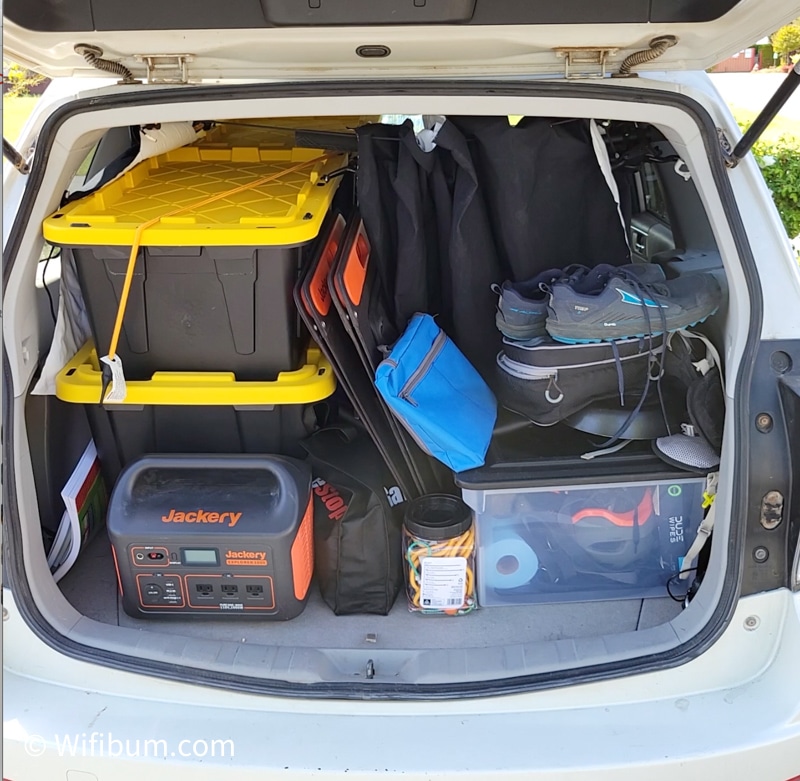
The Jackery Pro has a Cooler Display
The Pro version looks cooler and sleeker. It also gives you an estimate of how long your battery will last at the current rate of usage which is definitely a nice feature.
What appliances can a Jackery Power Station Power?
Infographic coming soon!
Summary: What Jackery Power Station is Right for You?
Camping: Start at Jackery 160 and go up to 300 depending on the amount of people and length of time you
Working Remotely: If it’s just for weekends, start at a Jackery 300. If it’s several days more often than not, then start at Jackery 1000 and get a couple solar panels.
Home Emergency Backup: Start at 1500 and go up if necessary
If you have a specific use case running a CPAP machine, I will defer to CPAPSupplies.com which has a much better article than I could ever write on it.
